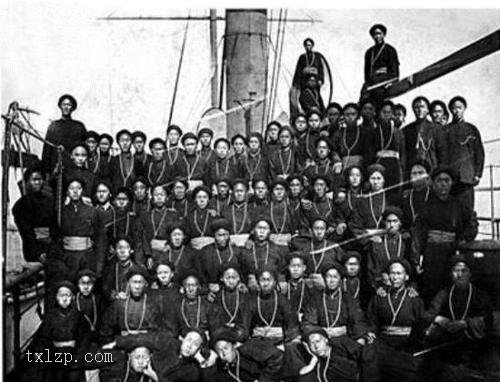Period:Unknown Production date:907-1125
Materials:stoneware
Technique:glazed
Subjects:arhat
Dimensions:Height: 103 centimetres Weight: 106 kilograms (Base) Weight: 120 kilograms (Figure)
Description:
Life-size, seated figure of a ‘luohan’ (arhat), with hands on lap, on a plinth with perforated front, the robes green and brown with stripes bordered blue. Made of lead-glazed stoneware.
IMG
![图片[1]-figure BM-1913-1221.1-China Archive](https://chinaarchive.net/Unknown/Ceramics/mid_00167763_001.jpg)
![图片[2]-figure BM-1913-1221.1-China Archive](https://chinaarchive.net/Unknown/Ceramics/mid_00506475_001.jpg)
![图片[3]-figure BM-1913-1221.1-China Archive](https://chinaarchive.net/Unknown/Ceramics/mid_00507376_001.jpg)
![图片[4]-figure BM-1913-1221.1-China Archive](https://chinaarchive.net/Unknown/Ceramics/mid_00031201_001.jpg)
![图片[5]-figure BM-1913-1221.1-China Archive](https://chinaarchive.net/Unknown/Ceramics/mid_RRC6143.jpg)
![图片[5]-figure BM-1913-1221.1-China Archive](https://chinaarchive.net/Unknown/Ceramics/mid_RRC6143.jpg)
![图片[7]-figure BM-1913-1221.1-China Archive](https://chinaarchive.net/Unknown/Ceramics/mid_RRC6143R.jpg)
![图片[8]-figure BM-1913-1221.1-China Archive](https://chinaarchive.net/Unknown/Ceramics/mid_RRC6143L.jpg)
Comments:See ‘Burlington Magazine’, May 1914, p. 69. Zwalf 1985An austere youthful ‘luohan’ (arhat), this ceramic sculpture belongs to the celebrated set of sixteen or eighteen once placed in caves to the west of Yixian, Hebei province. The surviving ‘lohan’ from the set are so individually modelled that they have been considered portraits of eminent monks; however, a tradition of representating ‘lohan’ with very human faces certainly existed in China since the middle Tang, as evidenced by those surrounding Śākyamuni in no. 312. The Yixian figures are striking for their sombre dignity and power, and have nothing of the elevated caricature associated with Chan ‘lohan’ painting of the Five Dynasties and Song periods. The clay images in a ‘maṇḍala’ of the Three Worlds and Ten Directions within the 11th-century library at the Huayan si, Datong, include similarly imposing ‘lohan’. Rawson 1992:Made in the tradition of Tang dynasty portraiture of monks and priests, it represents the aspirations of the educated man to attain spiritual enlightenment.Large glazed ceramic figures such as this one extended to Buddhism the tradition of moulding and modelling developed for pottery tomb figures. In the Ming and Qing periods imposing representations of many different Buddhist and Daoist deities were made, and their brilliant glazing resembles that of the tiles and figures decorating temple buildings. Michaelson 2006:’Luohan’ were disciples of the Buddha who had magical powers and could stay alive indefinitely to preserve the Buddha’s teachings. In China they were often shown in groups of sixteen or eighteen, with sets of ‘luohan’ figures placed along the side walls of a temple’s entrance or in groups of pairs on either side of the main Buddha figure. The stern but serene face gives the impression of an individual while at the same time suggesting a commanding religious belief, thereby promoting the idea that all humanity might aspire to the spiritual understanding represented by the ‘luohan’.The figure is glazed in the ‘sancai’ (three-colour) lead palette characteristic of the Tang dynasty. Following the gently curving surface of the body, a network of vertical and horizontal bands denote the patchwork characteristic of a monk’s mantle which was worn as a sign of humility. Monks generally owned only two possessions: their patchwork robe and a begging bowl.
Materials:stoneware
Technique:glazed
Subjects:arhat
Dimensions:Height: 103 centimetres Weight: 106 kilograms (Base) Weight: 120 kilograms (Figure)
Description:
Life-size, seated figure of a ‘luohan’ (arhat), with hands on lap, on a plinth with perforated front, the robes green and brown with stripes bordered blue. Made of lead-glazed stoneware.
IMG
![图片[1]-figure BM-1913-1221.1-China Archive](https://chinaarchive.net/Unknown/Ceramics/mid_00167763_001.jpg)
![图片[2]-figure BM-1913-1221.1-China Archive](https://chinaarchive.net/Unknown/Ceramics/mid_00506475_001.jpg)
![图片[3]-figure BM-1913-1221.1-China Archive](https://chinaarchive.net/Unknown/Ceramics/mid_00507376_001.jpg)
![图片[4]-figure BM-1913-1221.1-China Archive](https://chinaarchive.net/Unknown/Ceramics/mid_00031201_001.jpg)
![图片[5]-figure BM-1913-1221.1-China Archive](https://chinaarchive.net/Unknown/Ceramics/mid_RRC6143.jpg)
![图片[5]-figure BM-1913-1221.1-China Archive](https://chinaarchive.net/Unknown/Ceramics/mid_RRC6143.jpg)
![图片[7]-figure BM-1913-1221.1-China Archive](https://chinaarchive.net/Unknown/Ceramics/mid_RRC6143R.jpg)
![图片[8]-figure BM-1913-1221.1-China Archive](https://chinaarchive.net/Unknown/Ceramics/mid_RRC6143L.jpg)
Comments:See ‘Burlington Magazine’, May 1914, p. 69. Zwalf 1985An austere youthful ‘luohan’ (arhat), this ceramic sculpture belongs to the celebrated set of sixteen or eighteen once placed in caves to the west of Yixian, Hebei province. The surviving ‘lohan’ from the set are so individually modelled that they have been considered portraits of eminent monks; however, a tradition of representating ‘lohan’ with very human faces certainly existed in China since the middle Tang, as evidenced by those surrounding Śākyamuni in no. 312. The Yixian figures are striking for their sombre dignity and power, and have nothing of the elevated caricature associated with Chan ‘lohan’ painting of the Five Dynasties and Song periods. The clay images in a ‘maṇḍala’ of the Three Worlds and Ten Directions within the 11th-century library at the Huayan si, Datong, include similarly imposing ‘lohan’. Rawson 1992:Made in the tradition of Tang dynasty portraiture of monks and priests, it represents the aspirations of the educated man to attain spiritual enlightenment.Large glazed ceramic figures such as this one extended to Buddhism the tradition of moulding and modelling developed for pottery tomb figures. In the Ming and Qing periods imposing representations of many different Buddhist and Daoist deities were made, and their brilliant glazing resembles that of the tiles and figures decorating temple buildings. Michaelson 2006:’Luohan’ were disciples of the Buddha who had magical powers and could stay alive indefinitely to preserve the Buddha’s teachings. In China they were often shown in groups of sixteen or eighteen, with sets of ‘luohan’ figures placed along the side walls of a temple’s entrance or in groups of pairs on either side of the main Buddha figure. The stern but serene face gives the impression of an individual while at the same time suggesting a commanding religious belief, thereby promoting the idea that all humanity might aspire to the spiritual understanding represented by the ‘luohan’.The figure is glazed in the ‘sancai’ (three-colour) lead palette characteristic of the Tang dynasty. Following the gently curving surface of the body, a network of vertical and horizontal bands denote the patchwork characteristic of a monk’s mantle which was worn as a sign of humility. Monks generally owned only two possessions: their patchwork robe and a begging bowl.
© Copyright
The copyright of the article belongs to the author, please keep the original link for reprinting.
THE END



![[Qing Dynasty] British female painter—Elizabeth Keith, using woodblock prints to record China from the late Qing Dynasty to the early Republic of China—1915-China Archive](https://chinaarchive.net/wp-content/uploads/2022/11/image-191x300.png)

